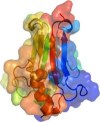
In this week’s SpectroscopyNOW column, I cover a wide range of subjects with the usual hint of spectroscopy, informatics, and crystallography. First up is a study on a unique protein, MitoNEET.
The protein was previously identified as a putative site for the activity of diabetes drugs known as thiazolidinediones, or which Actos is an example. The determination of the protein’s three-dimensional crystal structure coupled with bioinformatics information demonstrates that it is a clear target for small molecules. The mode of action was previously linked to an entirely different protein, according to biophysical chemist Patricia Jennings and physicist Mark Paddock, and their colleagues at the University of California at San Diego (UCSD) and Stanford Synchrotron Radiation Laboratory and the Hebrew University of Jerusalem, Israel.
“This is the first time that a protein like this has ever been found,” explains Paddock, “It is a brand new structure, a unique beast, which makes it an exciting target for structure-based drug design.” The structure shows two protomers intertwined to form a unique dimeric structure, explain the researchers, this constitutes a new fold not only among the 650 known Fe-S proteins structures but also among all known proteins.
Given that there is at least one clinically tested drug in this area it shouldn’t be too long before other novel compounds that can moderate insulin by interacting with MitoNEET are being investigated. However, it does highlight once again just how hit and miss the drug discovery process can be if the thiazolidinediones are not actually targeting the protein with which they were initially thought to interact.
Also in this week’s issue, more on the crab metabolite story from last week, copper blues and the toxic mouse, and Rod of Titania, the new superhero that could improve energy technologies and sunscreen simultaneously.